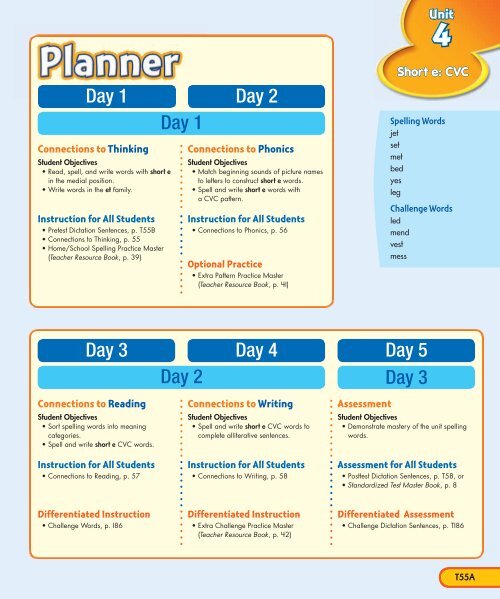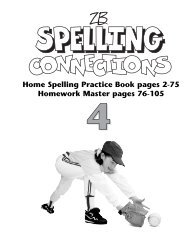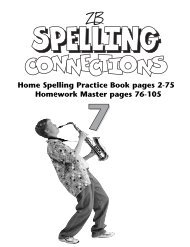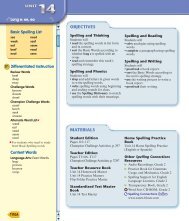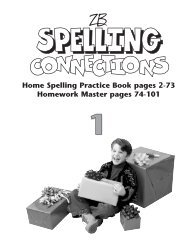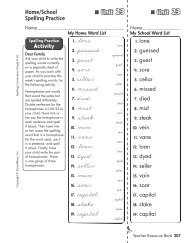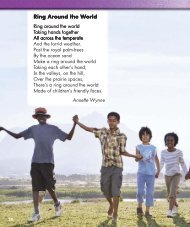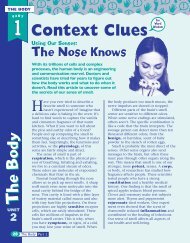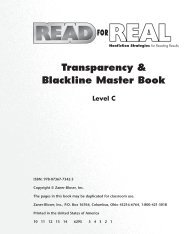4 - Zaner-Bloser
4 - Zaner-Bloser
4 - Zaner-Bloser
Create successful ePaper yourself
Turn your PDF publications into a flip-book with our unique Google optimized e-Paper software.
Day 1 Day 2<br />
Day 1<br />
Connections to Thinking<br />
Student Objectives<br />
• Read, spell, and write words with short e<br />
in the medial position.<br />
• Write words in the et family.<br />
Instruction for All Students<br />
• Pretest Dictation Sentences, p. T55B<br />
• Connections to Thinking, p. 55<br />
• Home/School Spelling Practice Master<br />
(Teacher Resource Book, p. 39)<br />
Day 3<br />
Connections to Reading<br />
Student Objectives<br />
• Sort spelling words into meaning<br />
categories.<br />
• Spell and write short e CVC words.<br />
Instruction for All Students<br />
• Connections to Reading, p. 57<br />
Differentiated Instruction<br />
• Challenge Words, p. 186<br />
Connections to Phonics<br />
Student Objectives<br />
• Match beginning sounds of picture names<br />
to letters to construct short e words.<br />
• Spell and write short e words with<br />
a CVC pattern.<br />
Instruction for All Students<br />
• Connections to Phonics, p. 56<br />
Optional Practice<br />
• Extra Pattern Practice Master<br />
(Teacher Resource Book, p. 41)<br />
Day 4 Day 5<br />
Day 2 Day 3<br />
Connections to Writing<br />
Student Objectives<br />
• Spell and write short e CVC words to<br />
complete alliterative sentences.<br />
Instruction for All Students<br />
• Connections to Writing, p. 58<br />
Differentiated Instruction<br />
• Extra Challenge Practice Master<br />
(Teacher Resource Book, p. 42)<br />
Assessment<br />
Unit<br />
4<br />
Short e: CVC<br />
Spelling Words<br />
jet<br />
set<br />
met<br />
bed<br />
yes<br />
leg<br />
Challenge Words<br />
led<br />
mend<br />
vest<br />
mess<br />
Student Objectives<br />
• Demonstrate mastery of the unit spelling<br />
words.<br />
Assessment for All Students<br />
• Posttest Dictation Sentences, p. T58, or<br />
• Standardized Test Master Book,<br />
p. 8<br />
Differentiated Assessment<br />
• Challenge Dictation Sentences, p. T186<br />
T55A
T55B<br />
Unit<br />
4<br />
Short e: CVC<br />
Unit 4 Materials<br />
Student Edition<br />
pp. 55–58, 186<br />
Teacher Edition<br />
pp. T55A–T58, T186<br />
Teacher Resource Book<br />
Unit 4 Practice Masters,<br />
pp. 39–42, and<br />
Sound/Symbol Cards<br />
Standardized Test Master Book<br />
Unit 4 Test Master, p. 8<br />
Word Sort CD-ROM<br />
Unit 4 Word Sort Cards for Teacher-<br />
Led Sorts and Student Sorts<br />
Assessment<br />
Pretest Sentences (See procedures on p. Z30.)<br />
1. The jet was flying low.<br />
2. Please set the dish on the table.<br />
3. I met a real clown!<br />
4. May Karen sleep in my bed?<br />
5. My mother said yes.<br />
6. Can you hop on one leg?<br />
Digital Resources for<br />
Spelling Connections<br />
Unit 4<br />
Spelling Connections Online<br />
www.spellingconnectionsonline.com<br />
Spelling Support for<br />
English Language Learners*<br />
Unit 4 Practice Masters and<br />
Audio Conversation<br />
Spelling Center Activities*<br />
Spelling Game Mats<br />
Flip Folder, TRB, p. 155<br />
*Spelling Support for English Language<br />
Learners and Spelling Center Activities may<br />
be used at any time during the week.<br />
The Science of Spelling<br />
When a single vowel appears in a<br />
closed syllable, it is usually short. Short<br />
vowel sounds rarely occur at the end of a<br />
word. Many CVC, CVCC, and CCVCC<br />
words have /ĕ/, as in net, next, and<br />
shell. There are relatively few high<br />
frequency words that begin with /ĕ/.<br />
(echo, edge, edit, educate, effort, egg,<br />
elbow, elephant, elm, end, engine, exit,<br />
and extra) Many students have trouble<br />
distinguishing the sounds of /ă/ and<br />
/ĕ/ (man/men) and /ĕ/ and /ĭ/ (pen/<br />
pin), so they confuse the spellings.
Choose from the activities below to reinforce English language acquisition.<br />
Word Meaning Write each spelling word on a flash card.<br />
Show each word and read it aloud. Use real objects, pictures, and<br />
pantomime to support meaning.<br />
Beginning, Middle, End Say a spelling word. Have one<br />
student say the beginning sound, have a second student say the<br />
middle sound, and have a third student say the ending sound.<br />
Write the word on the board and have students copy it. Continue<br />
with the remaining spelling words.<br />
Letter Substitution Write e on the board and say /ĕ/. Say<br />
each spelling word and have students repeat after you individually<br />
and in chorus. Then write et on the board. Have students say the<br />
word. Add j before et and have students say the word. Then erase j<br />
and add s. Continue with m. Invite students to suggest other<br />
beginning letters to make more words with et. (bet, get, let, net, pet,<br />
vet, wet, yet)<br />
Support for Spanish Speakers<br />
Help students pronounce the short e sound. Have them notice<br />
that when they say /ĕ/ their mouth is open and their tongue is<br />
behind their bottom teeth. Say /ĕ/ and have students repeat.<br />
Contrast this with saying the name of the letter e when their lips<br />
are stretched wider as though smiling.<br />
Beginning<br />
Intermediate<br />
Unit<br />
4<br />
Word Match Have students make flash cards for the spelling<br />
words or provide students with cards. Have students place the<br />
cards faceup. Read a spelling word aloud. Have students find the<br />
word and hold up the card.<br />
What Am I? Have students work in pairs to complete the<br />
activities on page 9 of Spelling Support for English Language<br />
Learners.<br />
Nouns and Verbs Explain that nouns are words that name<br />
things, and verbs are words that name actions. Use net and ran as<br />
examples. Say and define each word. Then create a two-column<br />
chart with net and ran as column heads. Have students categorize<br />
other spelling words by writing them in the appropriate column.<br />
Add words to the chart each week.<br />
What Am I? Have students work in pairs to complete the<br />
activities on page 9 of Spelling Support for English Language<br />
Learners.<br />
Play a “Simon Says” type of game to practice pronouncing and<br />
reading the short a and short e sounds. Have students make<br />
flash cards for short a and short e word pairs such as pat and<br />
pet, bad and bed, pan and pen. Start by having students put one<br />
pair of cards faceup on their desk. Say, Simon says pat. Hold up<br />
the card that says pat. Have students hold up their pat card and<br />
say the word. Gradually increase the number of words students<br />
choose from, using up to six cards (three pairs).<br />
T55C
__________<br />
nd<br />
ds.<br />
one<br />
cards<br />
ne<br />
e<br />
o<br />
r<br />
t<br />
3 Audio Riddles Conversation 24<br />
ith the<br />
Spelling Connections Grade 1<br />
Copyright © <strong>Zaner</strong>-<strong>Bloser</strong>, Inc.<br />
Copyright © <strong>Zaner</strong>-<strong>Bloser</strong>, Inc. Spelling Connections Grade 1<br />
Name ______________________________________________________________________________________________________<br />
Speaker 1 We have a new cat.<br />
bed leg<br />
Speaker 2 What kind of cat is it?<br />
yes jet<br />
Write the word from the box that answers the question What am I?<br />
Speaker 1 It has a long tail and a black nose.<br />
Speaker 2 Jim has a cat like that.<br />
1. I am a kind of plane. What am I? efghghghghghghghghghghghghghgh<br />
Speaker 1 I am glad that Jim has a cat.<br />
2. Speaker You sleep 2 on me. What am I? efghghghghghghghghghghghghghgh<br />
I am, too. A cat can be cute and fun.<br />
42 English Language Learners<br />
3. I have a knee. What am I? efghghghghghghghghghghghghghgh<br />
2011 Spelling Connections ELL_G1_ 978-0-7367-6921-1<br />
4. I am the opposite of no. What am I? efghghghghghghghghghghghghghgh<br />
T55D<br />
Unit<br />
4<br />
Choose from the activities below to reinforce English language acquisition.<br />
Advanced<br />
Word Meaning List the spelling words on the board and read<br />
each word aloud as you point to it. Ask students to identify any<br />
words they do not know. Use real objects, pictures, and<br />
pantomime to support explanations of word meaning.<br />
Finish the Sentence Write a question on the board that uses<br />
one or two spelling words, such as Does a jet have a leg? Ask a<br />
volunteer to read the sentence. Write a sentence that answers the<br />
question, but leave out the spelling words: A does not have<br />
a . Ask students which spelling words are missing and write<br />
the words on the lines. ( jet, leg) Ask a volunteer to read the<br />
answer. Continue the activity using the rest of the words.<br />
Word Meaning List the spelling words on the board and read<br />
each word aloud as you point to it. Ask students to identify any<br />
words they do not know. Use real objects, pictures, and<br />
pantomime to support explanations of word meaning.<br />
Story Words Encourage students to draw a picture that includes<br />
illustrations of spelling words. Then have students use the spelling<br />
words to tell a partner about their picture. The partner can write<br />
the spelling words heard in the story.<br />
Audio Conversation<br />
Name ______________________________________________________________________________________________________<br />
Speaker 1<br />
Speaker 2<br />
Is that your dad?<br />
Yes, that’s my dad.<br />
Write a new riddle for a word from the box. Ask the class<br />
to guess the word.<br />
English Language Learners<br />
1<br />
9<br />
Spelling Connections Grade 1<br />
Copyright © <strong>Zaner</strong>-<strong>Bloser</strong>, Inc.<br />
Copyright © <strong>Zaner</strong>-<strong>Bloser</strong>, Inc. Spelling Connections Grade 1<br />
Audio Conversation<br />
Name ______________________________________________________________________________________________________<br />
Speaker 1 He is a big man!<br />
Speaker 1 How will the men get her pet?<br />
Speaker 2<br />
Speaker 2<br />
He can pick me up.<br />
The men will use a net.<br />
Speaker 1<br />
Speaker 1<br />
Spelling Can he run fast? Support for English A net will Language save the pet. Learners<br />
Speaker 2 Yes. My dad ran fast to get to the bus.<br />
Speaker 2 Ann will thank the men.<br />
2011 Spelling Connections ELL_G1_ 978-0-7367-6921-1<br />
Practice Master, p. 9<br />
Speaker 1<br />
Speaker 2<br />
Audio Conversation Word List 4 3 Word List<br />
Name ______________________________________________________________________________________________________<br />
Speaker 1<br />
Speaker 2<br />
Speaker 1<br />
Speaker 2<br />
Speaker 1<br />
Speaker 2<br />
Ann has lost her pet. It is a white cat.<br />
Two men saw it in a tree by the pen.<br />
Did you hear the jet?<br />
Yes, it made me fall out of bed!<br />
Why were you in bed?<br />
I hurt my leg. I wanted to rest it.<br />
Is your leg better now?<br />
Yes, but now I hurt my arm!<br />
Practice Master, p. 43<br />
2011 Spelling Connections ELL_G1_ 978-0-7367-6921-1<br />
Audio Conversation<br />
available on CD<br />
Advanced High<br />
English Spanish English Spanish<br />
1. let dar; dejar;<br />
permitir<br />
1. jet chorro<br />
2. get obtener<br />
3. net red<br />
4. pet animalito;<br />
mascota<br />
English Language Learners 43<br />
5. pen pluma; corral<br />
3<br />
6. men hombres<br />
58 English Language Learners<br />
2011 Spelling Connections ELL_G1_ 978-0-7367-6921-1<br />
True or False Use a spelling word in a statement that is true or<br />
false. For example, Yes means the opposite of no. I rode the jet to<br />
school. Have students say true if the sentence makes sense. If the<br />
sentence is false, ask students to explain why. Then have them use<br />
the spelling word in a true sentence.<br />
What Am I? Have students work in pairs to complete the<br />
activities on page 9 of Spelling Support for English Language<br />
Learners.<br />
What Am I? Have students work in pairs to complete the<br />
activities on page 9 of Spelling Support for English Language<br />
Learners.<br />
2. set poner<br />
3. met encontró<br />
4. bed cama<br />
5. yes sí<br />
6. leg pierna<br />
4<br />
English/Spanish<br />
Word List, p. 58<br />
Spelling Connections Grade 1<br />
Copyright © <strong>Zaner</strong>-<strong>Bloser</strong>, Inc.<br />
Spelling Connections Online<br />
Interactive online spelling activities<br />
provide additional ELL support.<br />
www.spellingconnectionsonline.com
EFGHGHGHGHGHGHGHGH jet<br />
EFGHGHGHGHGHGHGHGH set<br />
EFGHGHGHGHGHGHGHGH met<br />
EFGHGHGHGHGHGHGHGH bed<br />
EFGHGHGHGHGHGHGHGH yes<br />
EFGHGHGHGHGHGHGHGH l e g<br />
1.<br />
2.<br />
3.<br />
4.<br />
5.<br />
6.<br />
This unit targets the<br />
short e sound. Ask<br />
your child to read the<br />
spelling words aloud.<br />
Connections to<br />
2011 Spelling Connections SE_G1_978-0-7367-6855-9<br />
Home/School Practice<br />
Home/School Spelling<br />
Practice Master, TRB, p. 39<br />
Copyright © <strong>Zaner</strong>-<strong>Bloser</strong>, Inc. Spelling Connections Grade 1<br />
Home/School<br />
Spelling Practice<br />
EFGHGHGHGHGHGHGHGH<br />
1. jet<br />
EFGHGHGHGHGHGHGHGH<br />
2. set<br />
EFGHGHGHGHGHGHGHGH<br />
3. met<br />
EFGHGHGHGHGHGHGHGH<br />
4. bed<br />
EFGHGHGHGHGHGHGHGH<br />
5. yes<br />
EFGHGHGHGHGHGHGHGH<br />
6. leg<br />
A. Write the spelling words that end with et.<br />
efghghghghghghghghghghghghgh EFGHGHGHGHGHGHGHGHGHGHGHGHGH<br />
jet set<br />
EFGHGHGHGHGHGHGHGHGHGHGHGHGH met<br />
1.<br />
3.<br />
B. Write a spelling word to name each picture.<br />
efghghghghghghghghghghghghgh leg<br />
efghghghghghghghghghghghghgh bed<br />
EFGHGHGHGHGHGHGHGHGHGHGHGHGH yes<br />
4.<br />
5.<br />
6.<br />
Name ______________________________________________________________________________________________________<br />
Dear Family,<br />
Ask your child to write the spelling words<br />
correctly on the blank lines.<br />
Play a game by having your child guess a<br />
spelling word from clues you give. For example,<br />
EFGHGHGHGHGHGHGHGHGHGHGHGHGHGHGHGHGHGHGHGHGHGHGHGH<br />
1.<br />
EFGHGHGHGHGHGHGHGHGHGHGHGHGHGHGHGHGHGHGHGHGHGHGHGH<br />
2.<br />
EFGHGHGHGHGHGHGHGHGHGHGHGHGHGHGHGHGHGHGHGHGHGHGHGH<br />
3.<br />
EFGHGHGHGHGHGHGHGHGHGHGHGHGHGHGHGHGHGHGHGHGHGHGHGH<br />
4.<br />
EFGHGHGHGHGHGHGHGHGHGHGHGHGHGHGHGHGHGHGHGHGHGHGHGH<br />
5.<br />
EFGHGHGHGHGHGHGHGHGHGHGHGHGHGHGHGHGHGHGHGHGHGHGHGH<br />
6.<br />
Spelling Practice Activity<br />
for the word yes, you might say, “This word is the<br />
opposite of no.” Once your child has guessed the<br />
correct spelling word, help him or her write the<br />
word on a separate sheet of paper.<br />
4<br />
Teacher Resource Book 39<br />
Práctica de ortografía<br />
para el hogar o la escuela<br />
EFGHGHGHGHGHGHGHGH<br />
1. jet chorro<br />
EFGHGHGHGHGHGHGHGH<br />
2. set poner<br />
EFGHGHGHGHGHGHGHGH<br />
3. metencontró<br />
EFGHGHGHGHGHGHGHGH<br />
4. bed cama<br />
EFGHGHGHGHGHGHGHGH<br />
5. yes sí<br />
EFGHGHGHGHGHGHGHGH<br />
6. leg<br />
40 Teacher Resource Book<br />
2.<br />
Home/School Spelling<br />
Practice Master, TRB, p. 40<br />
Nombre ___________________________________________________________________________________________________<br />
efghghghghghghghghghghghghghghghghghghghghghghghgh<br />
1.<br />
efghghghghghghghghghghghghghghghghghghghghghghghgh<br />
2.<br />
efghghghghghghghghghghghghghghghghghghghghghghghgh<br />
3.<br />
efghghghghghghghghghghghghghghghghghghghghghghghgh<br />
4.<br />
efghghghghghghghghghghghghghghghghghghghghghghghgh<br />
5.<br />
EFGHGHGHGHGHGHGHGHGHGHGHGHGHGHGHGHGHGHGHGHGHGHGHGH<br />
6.<br />
2011 Spelling Connections TRB_G1_ 978-0-7367-6927-3<br />
2011 Spelling Connections TRB_G1_ 978-0-7367-6927-3<br />
English Spanish<br />
pierna<br />
Querida familia:<br />
Pida a su hijo(a) que escriba correctamente<br />
las palabras de ortografía en los renglones<br />
en blanco.<br />
Actividad de ortografía<br />
Juegue a las “Claves” con su hijo(a). Pídale que<br />
adivine una palabra de la lista de palabras y que<br />
luego la deletree, a partir de una o varias pistas<br />
que Ud. le dé. Por ejemplo, para la palabra yes<br />
(sí) puede decir: “Esta palabra es lo opuesto de<br />
no”. Si la deletrea correctamente, dígale que la<br />
escriba en una hoja aparte.<br />
4<br />
Spelling Connections Grade 1<br />
Copyright © <strong>Zaner</strong>-<strong>Bloser</strong>, Inc.<br />
Unit<br />
4<br />
Short e:<br />
cvc<br />
55<br />
Day 1<br />
Student Objectives<br />
Unit<br />
4<br />
• Read, spell, and write words with short e<br />
in the medial position.<br />
• Write words in the et family.<br />
Unit Pretest<br />
• Administer the pretest on page T55B.<br />
Teaching Tips<br />
• Have students read the spelling words<br />
aloud, emphasizing and listening to /ĕ/.<br />
CD-ROM<br />
• Conduct a Teacher-Led Sort (see p. Z31)<br />
to reinforce the spelling pattern.<br />
• Display or draw a picture of a jet. Have<br />
students name the picture. Write jet on<br />
the board. Have students name the vowel<br />
sound they hear and tell where it is in the<br />
word.<br />
• Tell students that a spelling word rhymes<br />
with jet and begins with the letter s. Ask<br />
a volunteer to name the word and write it<br />
below jet. Do the same with met. Have<br />
students identify the rhyming sounds.<br />
• Nod your head up and down and have<br />
students name the spelling word that tells<br />
what you are gesturing. (yes)<br />
• Have students complete the page<br />
independently or as a class.<br />
Home/School Word Lists<br />
• Have students take home the Home/<br />
School Spelling Practice Master.<br />
T55
Copyright © <strong>Zaner</strong>-<strong>Bloser</strong>, Inc. Spelling Connections Grade 1<br />
Extra Pattern Practice<br />
Name ______________________________________________________________________________________________________<br />
jet set met bed yes leg<br />
Use spelling words to answer the clues.<br />
Write the spelling words in the puzzle.<br />
Across<br />
3. The sun has _____.<br />
5.<br />
6. I _____ a man.<br />
1. 2.<br />
y<br />
3.<br />
5.<br />
4.<br />
t<br />
2011 Spelling Connections TRB_G1_ 978-0-7367-6927-3<br />
T56<br />
Unit<br />
4 Day 2<br />
Student Objectives<br />
• Match beginning sounds of picture names<br />
to letters to construct short e words.<br />
• Spell and write short e words with a CVC<br />
pattern.<br />
Teaching Tips<br />
• Say the spelling words. Point out that all<br />
of the words have the short e sound<br />
spelled with one vowel between two<br />
consonants.<br />
• Say jet, emphasizing the individual sounds<br />
/j/ /ĕ/ /t/. Have students say each spelling<br />
word slowly and listen for the beginning,<br />
middle, and ending sound.<br />
• Display pictures of an egg, the numeral 10,<br />
and a jar. Ask students to identify the<br />
picture that begins with the same sound as<br />
jet. ( jar) Continue with the medial and end<br />
sounds.<br />
• Have students complete page 56<br />
independently or as a class.<br />
Extra Pattern Practice<br />
• Use the optional practice master below<br />
for extra practice with short e.<br />
Extra Pattern Practice<br />
Extra Pattern Practice Master,<br />
TRB, p. 41<br />
6.<br />
t<br />
CD-ROM<br />
• Provide time for students to use a<br />
Buddy Sort (see p. Z31) to practice their<br />
spelling words with a partner.<br />
Down<br />
1. You can say _____ or no.<br />
2.<br />
4.<br />
4<br />
Teacher Resource Book 41<br />
56<br />
Connections to<br />
Write the spelling word that begins with the same<br />
sound and letter as the picture name.<br />
1. 2.<br />
EFGHGHGHGHGHGHGHGHGHGHGHGHGHGHGHGH EFGHGHGHGHGHGHGHGHGHGHGHGHGHGHGHGH<br />
met bed<br />
3. 4.<br />
EFGHGHGHGHGHGHGHGHGHGHGHGHGHGHGHGH EFGHGHGHGHGHGHGHGHGHGHGHGHGHGHGHGH<br />
yes jet<br />
5. 6.<br />
EFGHGHGHGHGHGHGHGHGHGHGHGHGHGHGHGH EFGHGHGHGHGHGHGHGHGHGHGHGHGHGHGHGH<br />
leg set<br />
2011 Spelling Connections SE_G1_978-0-7367-6855-9<br />
jet<br />
set<br />
met<br />
bed<br />
yes<br />
leg<br />
Pattern Practice Game: / ĕ /<br />
Have a student write an e on a sheet of paper. A partner writes a consonant on the<br />
left and on the right of the e to construct a short e word. Then have partners<br />
switch. Have students continue until they have written several short e words.
2011 Spelling Connections SE_G1_978-0-7367-6855-9<br />
Connections to<br />
A. Write the spelling words that name things.<br />
efghghghghghghghghghghghghgh EFGHGHGHGHGHGHGHGHGHGHGHGHGH<br />
bed jet<br />
EFGHGHGHGHGHGHGHGHGHGHGHGHGH leg<br />
1.<br />
3.<br />
B. Write the spelling words that tell an action.<br />
EFGHGHGHGHGHGHGHGHGHGHGHGHGH EFGHGHGHGHGHGHGHGHGHGHGHGHGH<br />
4. met set<br />
C. Write the spelling word that is the opposite of “no.”<br />
EFGHGHGHGHGHGHGHGHGHGHGHGHGH<br />
6. yes<br />
2.<br />
5.<br />
More Fun With Spelling for Differentiation<br />
Digital Resources for<br />
Spelling Connections<br />
Interactive digital resources include word sorts,<br />
pattern practice, and proofreading activities<br />
for individual and whole-group instruction.<br />
(Interactive whiteboard compatible; see p. Z32.)<br />
Spelling Connections Online<br />
Interactive online spelling activities include<br />
word sorts, crossword puzzles, sentence<br />
completion, proofreading practice, and spelling<br />
bees with words from each unit (see p. Z32).<br />
www.spellingconnectionsonline.com<br />
jet<br />
set<br />
met<br />
bed<br />
yes<br />
leg<br />
57<br />
Day 3<br />
Student Objectives<br />
Teaching Tips<br />
Unit<br />
4<br />
• Sort spelling words into meaning<br />
categories.<br />
• Spell and write short e CVC words.<br />
• Review that words can name things. Point<br />
to objects and have students name them.<br />
Then point to your leg. Have students say<br />
leg and write the word on a sheet of paper.<br />
• Explain that words can name actions.<br />
Clap your hands. Have students name the<br />
action. (clap) Then set a book on a desk.<br />
Have students write the word. (set)<br />
• Point out that some words are opposites.<br />
Open the door. Ask students to name<br />
what you did and then tell you the<br />
opposite. (open, close)<br />
• Have students complete the page<br />
independently or as a class.<br />
Differentiated Instruction<br />
• Use the Challenge Words activity on<br />
page 186 with students who are ready to<br />
transfer their knowledge of short e to<br />
new words.<br />
• An Extra Challenge Practice Master is<br />
available on page 42 in the TRB.<br />
• Dictation sentences for the challenge<br />
words are available on page T186.<br />
Spelling Center Activities<br />
Spelling Game Mats<br />
Place one of the spelling games in a learning center<br />
to provide a fun way for students to practice their<br />
spelling words (see p. Z26).<br />
Flip Folder<br />
Students can use a Flip Folder to practice spelling<br />
words independently (see p. Z32).<br />
Word Sort CD-ROM<br />
Printable, unit-specific word cards for spelling and<br />
challenge words can be used for Teacher-Led,<br />
Individual, Buddy, and Speed Sorts (see p. Z31).<br />
T57
T58<br />
Unit<br />
4 Day 4<br />
Student Objectives<br />
• Spell and write short e CVC words to<br />
complete alliterative sentences.<br />
Teaching Tips<br />
• To introduce alliteration, repeat a familiar<br />
tongue twister like Rubber baby buggy<br />
bumpers. Have students identify the sound<br />
that is repeated. Explain that poets often<br />
use repeated sound in their poems.<br />
• Have students complete the page<br />
independently or as a class. Have students<br />
read the sentences as fast as they can and<br />
then identify the sound that is repeated<br />
in each.<br />
• Guide students’ attention to item 5. Ask,<br />
What kind of letter do we write at the<br />
beginning of every sentence? (a capital or an<br />
uppercase letter) How should we write the<br />
word that starts this sentence? (start with a<br />
capital capital or uppercase Y)<br />
Day 5<br />
CD-ROM<br />
• Invite students to practice practice for the weekly<br />
test by doing an Individual Sort or a<br />
Speed Sort (see p. Z31).<br />
Student Objectives<br />
• Demonstrate mastery of the unit spelling<br />
words.<br />
Posttest Assessment Options<br />
Option 1: Administer the unit posttest using<br />
the dictation sentences at right.<br />
Option 2: Assess students using the<br />
standardized test. See the<br />
Standardized Test Master Book,<br />
p. 8.<br />
Note: Posttest sentences for the on level and<br />
challenge lists are available on the audio<br />
Spelling Connections Posttest CD.<br />
58<br />
Connections to<br />
Write a spelling word to finish each tongue twister.<br />
set<br />
1. Sue efghghghghghghghghghghghghghghghgh six shells in the shack.<br />
met<br />
2. Matt efghghghghghghghghghghghghghghghgh merry mice in the mud.<br />
3. Jack jumped on the jolly efghghghghghghghghghghghghghghghgh.<br />
4. Lucky laid down on Lil’s left EFGHGHGHGHGHGHGHGHGHGHGHGHGHGHGHGH.<br />
Yes<br />
5. efghghghghghghghghghghghghghghghgh, the yellow yak yelled, “Yippee!”<br />
bed<br />
EFGHGHGHGHGHGHGHGHGHGHGHGHGHGHGHGH 6. Bill’s has a blue blanket.<br />
1-Minute Handwriting Hint<br />
2011 Spelling Connections SE_G1_978-0-7367-6855-9<br />
The j consists of a vertical stroke and<br />
a curve-left stroke. The curve stroke<br />
is part of a circle motion.<br />
Posttest Sentences<br />
1. If you like bananas, write yes.<br />
2. Will you set this on my desk?<br />
3. Have you met my brother?<br />
4. I can make my own bed.<br />
5. My leg is asleep.<br />
6. I watched the jet land.<br />
jet<br />
leg<br />
KLKLKLKLKLKLKLKLKLKLKLKLKLKL j CURVE LEFT<br />
jet<br />
set<br />
met<br />
bed<br />
yes<br />
leg<br />
Standardized Test Master Book, p. 8<br />
Standardized Test 4<br />
Standardized<br />
Name<br />
Directions: Read each sentence. Look for spelling mistakes in the underlined words.<br />
Mark the answer that shows the correct spelling. Mark Correct as is if all the underlined<br />
words are written correctly.<br />
8<br />
1<br />
My legg has a small cut.<br />
A haz<br />
B cutt<br />
C leg<br />
D Correct as is<br />
3 My mom will say yez.<br />
A yes<br />
B wil<br />
C moom<br />
D Correct as is<br />
5 I mett Han and Jan in the<br />
hall.<br />
A ond<br />
B met<br />
C iin<br />
D Correct as is<br />
Standardized Test<br />
2011 Spelling Connections G1_STM 978-0-7367-6909-9<br />
2 Do not jump on the bed.<br />
A jup<br />
B beed<br />
C oon<br />
D Correct as is<br />
4 We got on the big jet.<br />
A onn<br />
B jat<br />
C bigg<br />
D Correct as is<br />
6 Len sett the books on the<br />
shelf.<br />
A onn<br />
B buks<br />
C set<br />
D Correct as is<br />
TACS_STM<br />
Spelling Connections Grade 1<br />
Copyright © <strong>Zaner</strong>-<strong>Bloser</strong>, Inc.<br />
Spelling Connections Grade 1<br />
Copyright © <strong>Zaner</strong>-<strong>Bloser</strong>, Inc.<br />
Name<br />
Directions: Fill i<br />
2011 Spelling Connections G1_<br />
1.<br />
2.<br />
3.<br />
4.<br />
5.<br />
6.<br />
7.<br />
8.<br />
9.<br />
10.<br />
Samp


